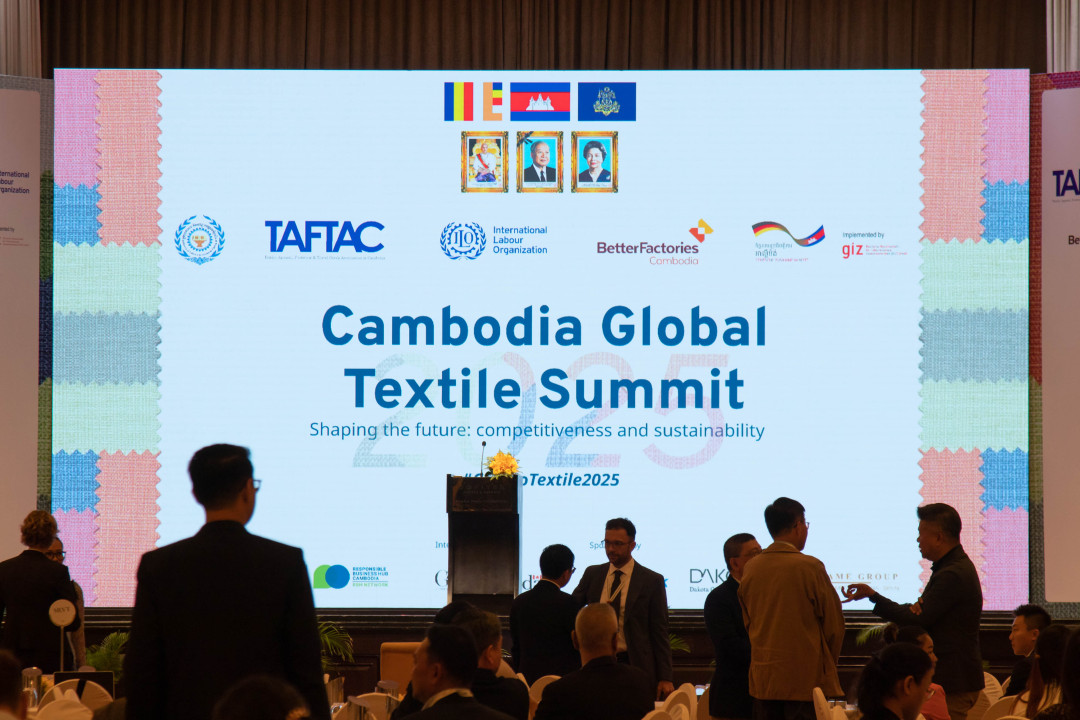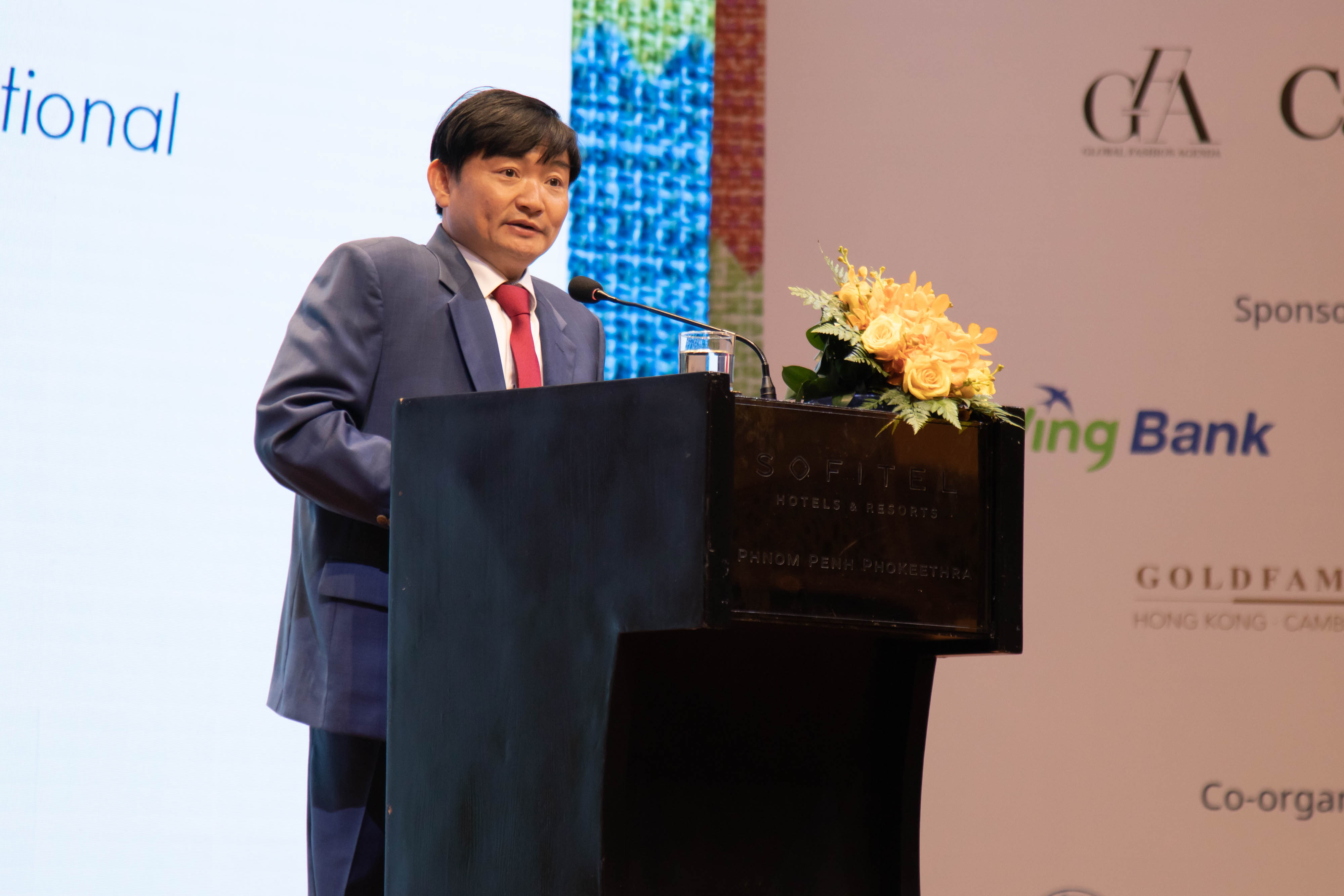Cambodia Global Textile Summit 2025: Highlighting the Kingdom’s Role in Global Supply Chains

The first Cambodia Global Textile Summit was held at the Sofitel Phnom Penh Phokeethra from March 31 - April 1, 2025, bringing together government leaders, representatives of international brands, industry stakeholders, employers, and workers' organisations to discuss various topics related to Cambodia’s garments and textiles industry, one of the four pillars of the country’s economy.
The two-day event was organised by the Textile, Apparel, Footwear & Travel Goods Association in Cambodia (TAFTAC), Better Factories Cambodia (BFC), EuroCham Cambodia, Deutsche Gesellschaft für Internationale Zusammenarbeit (GIZ) GmbH, with strong support from the Ministry of Labour and Vocational Training (MoLVT).
The event was opened by H.E. Sun Chanthol, Deputy Prime Minister (DPM) and First Vice-Chairman of the Council for the Development of Cambodia (CDC); H.E. Heng Sour, Minister of Labour and Vocational Training; Albert Tan, Deputy Chairman of TAFTAC; and Xiaoyan Qian, Country Director of the International Labour Organisation (ILO).
H.E. Heng Sour remarked on how the summit acts as an invaluable platform to showcase Cambodia’s achievements and strengths, address gaps, and explore ways to further enhance the textile sector during the current era of uncertainty marked by global trade tensions and a shifting economic landscape.
Cambodia’s GFT Industry Exports
In 2023, Cambodia ranked 15th in global garments, footwear and travel goods (GFT) exports and 3rd in the ASEAN region, accounting for almost 1.4 per cent of global exports, which totaled USD 762 billion in value. China was the top exporter, with 36 per cent of the world’s total GFT exports (USD 274.4 billion), followed by Italy (7.2 per cent or USD 54.8 billion) and Bangladesh (6.6 per cent or USD 50.6 billion).
According to the General Department of Customs and Excise (GDCE), in 2024, Cambodia’s GFT exports totaled USD 13.74 billion, accounting for over 50 per cent of the country’s total exports.
The labour minister shared that as of 2025, Cambodia has 1,608 textile, garment, footwear, and travel goods factories, employing more than 930,000 Cambodian workers, including almost 700,000 women. This sector generates an annual income of almost USD 3 billion for workers.

“Moreover, Cambodia has demonstrated a strong commitment to improving working conditions, as evidenced by the increase in the minimum wage from USD 45 in the 2000s, to USD 208 in 2025, plus other compulsory allowances of at least USD 15 a month,” he added.
For years, Cambodia has been a major supplier of textile products, particularly to the U.S. and European markets, thanks to political stability, strong government support and incentives, and improvements in infrastructure, including the ongoing expansion of special economic zones.
H.E. Heng Sour further emphasised, “Cambodia is well positioned to maintain and even expand its current textile production capacities. Our workforce of approximately 11 million working-age adults ensures that Cambodia is capable of meeting existing demand while accommodating increased orders from global buyers.”
Investment Opportunities in Cambodia
In his opening remarks, DPM Sun Chanthol shared that over the past five years, growth in exports from the textile industry has been phenomenal, with exports increasing annually. The country has benefited greatly from its geographic proximity to major Asian markets, offering unparalleled access to a rapidly growing consumer base.
In addition to Cambodia’s strategic location, he added that the country’s economy is also bolstered by its active membership in ASEAN, which enhances its connectivity and integration with global markets.
In 2024, the CDC approved 414 investment projects, an increase of 54 per cent compared to 2023, with a total capital of approximately USD 6.9 billion – 40 per cent more than in 2023.
The CDC’s first vice-chairman emphasised that to boost the Kingdom's industrial capacity and technological advancement, the heart of the government's economic strategy lies in the creation of a highly competitive, business-friendly environment. He added that the government has overhauled its investment law to reduce red tape and also provide competitive investment incentives such as extended tax holidays, reduced tax rates in critical sectors, and improved tax administration practices.
The CDC has also created an online investment project management system, CDCIPM, which allows investors to submit their investment applications online, reducing the average approval time from 20 days to 16 days.
DPM Sun Chanthol noted that Cambodia currently has free trade agreements (FTAs) with China and South Korea, a Comprehensive Economic Partnership with the United Arab Emirates (UAE), and is also a member of the Regional Comprehensive Economic Partnership (RCEP).
As Cambodia is about to graduate from least developed country (LDC) status, the government is working on building economic resilience and diverse trade relations, adopting technology and innovation, enhancing infrastructure, and developing Cambodia’s workforce.
Impact of U.S. Tariffs on Cambodia Garment Exports
Dr. Penghuy Ngov, Expert Consultant at International Economics Consulting Ltd, presented during the summit that Cambodia’s GFT sector is significantly dependent on exports to the United States compared to other key GFT exporters, making it more vulnerable to tariff changes and shifts in trade policy.

Penghuy told B2B Cambodia that U.S. and European markets accounted for around 65 per cent of Cambodia's GFT exports in 2023.
“It's a huge market, but relying on just a few markets is not safe, we need to diversify into other markets, if we can,” he said.
The Trump administration is changing some trade policies by imposing tariffs on certain countries. What if the United States imposes a tariff on Cambodia? If we rely heavily on exports to the US market, that will affect our exports. We need to be very careful about that.
Penghuy further added, “I believe that in the next five years, the garment sector will still be very important for Cambodia. Currently, over 900,000 people are directly employed, and around 2-3 million people are indirectly employed. From those employment numbers, we can see the significance of the industry itself.”
To boost Cambodia’s garment productivity, he advised investing in workforce development and adopting new technology.